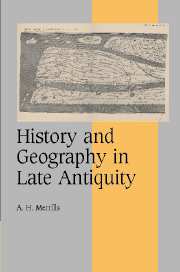Introduction: history's other eye
Published online by Cambridge University Press: 24 July 2009
Summary
Chronology and Geography are the two eyes of History.
Samuel Purchas, Pilgrimage, 2nd edn, p. 613Seven years after Alaric's sack of Rome in 410, and some five hundred miles away on the North African coast, the Spanish priest Orosius completed his Historiarum adversus paganos libri septem. At the very start of his piece, immediately after a brief declaration of the unprecedented chronological scope of his Historia, Orosius treated his audience to a long geographical passage, in a bold declaration of the spatial concerns of his ambitious work. Rattling through his chapter at some pace, the historian created nothing less than a succinct portrait of the fifth-century world, from India in the east to the Spanish provinces in the west, from the headwaters of the Nile in interior Africa to the mysterious Arctic island of Thule. The chapter is a central one within Orosius' work, and within the evolution of Latin historiography. Proudly situated at the very start of the Historia, the description of the world not only declared Orosius' own interests in the interaction of geographical and historical themes, it set the standard for Christian historical writing of the next half-millennium. Orosius' introduction demonstrated the extent to which Christian historians could express themselves and make sense of their world, not only through reference to the past, but through their interpretation of the physical world.
Orosius was not the first historian to grant geography so prominent a position within his historical narrative.
- Type
- Chapter
- Information
- History and Geography in Late Antiquity , pp. 1 - 34Publisher: Cambridge University PressPrint publication year: 2005

